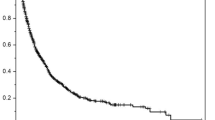Abstract
Purpose
Clinical staging is vital for treatment decision-making by renal cell carcinoma (RCC) patients. Some RCCs clinically appear T1 on CT, but are actually T3a due to extension into fat or renal vein, causing the tumor to be pathologically upstaged. The objective of this study to determine the rate, survival, and predictors of RCC upstaging, for patients with cT1 disease treated surgically.
Methods
Using the National Cancer Data Base Participant User File for RCC from 2004 to 2013, we selected AJCC cT1 patients, who underwent surgical resection and whose AJCC pathological T stage (pT) was available. Upstaging was characterized dichotomously—overall (any pT > T1) and pT3a-specific upstaging. Patient and tumor characteristics of those upstaged and not were compared using Chi-squared analyses. Multivariable logistic regression was used to analyze predictors of upstaging, and Cox proportional hazards regression was used to estimate overall survival hazards ratios.
Results
Overall upstaging (pT > T1) was observed in 8252 (7.1%) patients, and T3a-specific upstaging was observed in 3380 (5.4%) patients. Patients who were older, male, and had comorbidities, and tumors that were cT1b, underwent RN, and had high Fuhrman grade were at a higher risk of pathological upstaging. Upstaging led to a 40% increased risk of death compared to patients who were not upstaged.
Conclusion
The rate of upstaging is not negligible (5–7% of the time), negatively impacts survival, and various patient and tumor characteristics can be used to predict upstaging.

Similar content being viewed by others
References
Hüsch T, Reiter MA, Mager R, Kurosch M, Haferkamp A (2012) Treatment of locally advanced renal cell. Carcinoma. https://doi.org/10.1016/j.eursup.2012.04.003
Siegel RL, Miller KD, Jemal A (2016) Cancer statistics, 2016. CA Cancer J Clin 66(1):7–30. https://doi.org/10.3322/caac.21332
Novick AC, Campbell SC, Belldegrun A et al Guideline for management of the clinical stage 1 renal mass AUA staff: Chapter 1: management of the clinical stage 1 renal mass: diagnosis and treatment recommendations. https://www.auanet.org/common/pdf/education/clinical-guidance/Renal-Mass.pdf. Accessed 21 March 2017
Nayak JG, Patel P, Saarela O et al (2016) Pathological upstaging of clinical T1 to pathological T3a renal cell carcinoma: a multi-institutional analysis of short-term outcomes. Urology 94:154–160. https://doi.org/10.1016/j.urology.2016.03.029
Ramaswamy K, Kheterpal E, Pham H et al (2015) Significance of pathologic T3a upstaging in clinical T1 renal masses undergoing nephrectomy. Clin Genitourin Cancer 13(4):344–349. https://doi.org/10.1016/j.clgc.2015.01.001
Gorin MA, Ball MW, Pierorazio PM et al (2013) Outcomes and predictors of clinical T1 to pathological T3a tumor up-staging after robotic partial nephrectomy: a multi-institutional analysis. J Urol 190(5):1907–1911. https://doi.org/10.1016/j.juro.2013.06.014
Mouracade P, Kara O, Dagenais J et al (2017) Perioperative morbidity, oncological outcomes and predictors of pT3a upstaging for patients undergoing partial nephrectomy for cT1 tumors. World J Urol. https://doi.org/10.1007/s00345-017-2004-x
Tay MHW, Thamboo TP, Wu FMW et al (2014) High RENAL Nephrometry scores are associated with pathologic upstaging of clinical T1 renal-cell carcinomas in radical nephrectomy specimens: implications for nephron-sparing surgery. J Endourol 28(9):1138–1142. https://doi.org/10.1089/end.2014.0123
Shah PH, Moreira DM, Patel VR et al (2017) Partial nephrectomy is associated with higher risk of relapse compared with radical nephrectomy for clinical stage T1 renal cell carcinoma pathologically upstaged to T3a. J Urol. https://doi.org/10.1016/j.juro.2017.03.012
Weight CJ, Lythgoe C, Unnikrishnan R, Lane BR, Campbell SC, Fergany AF (2011) Partial nephrectomy does not compromise survival in patients with pathologic upstaging to pT2/pT3 or high-grade renal tumors compared with radical nephrectomy. Urology 77(5):1142–1146. https://doi.org/10.1016/j.urology.2010.11.058
Roberts W, Bhayani S, Allaf M, Chan T, Kavoussi L, Jarrett T (2005) Pathological stage does not alter the prognosis for renal lesions determined to be stage T1 by computerized tomography. J Urol 173(3):713–715. https://doi.org/10.1097/01.ju.0000153638.15018.58
Moch H, Artibani W, Delahunt B et al (2009) Reassessing the current UICC/AJCC TNM staging for renal cell carcinoma. Eur Urol. https://doi.org/10.1016/j.eururo.2009.06.036
Lam JS, Klatte T, Breda A (2009) Staging of renal cell carcinoma: current concepts. Indian J Urol 25(4):446–454. https://doi.org/10.4103/0970-1591.57906
Survival rates for kidney cancer by stage. http://www.cancer.org/cancer/kidneycancer/detailedguide/kidney-cancer-adult-survival-rates
Jeong S, Kim JK, Park J et al (2016) Pathological T3a upstaging of clinical T1 renal cell carcinoma: outcomes according to surgical technique and predictors of upstaging. PLoS ONE 11(11):e0166183. https://doi.org/10.1371/journal.pone.0166183
National Cancer Database. https://www.facs.org/quality-programs/cancer/ncdb. Accessed 1 April 2017
American College of Surgeons. Participant User Files|National Cancer Data Base—Data Dictionary PUF 2014. http://ncdbpuf.facs.org/About. Accessed 1 April 2017
Bilimoria KY, Stewart AK, Winchester DP, Ko CY (2008) The National Cancer Data Base: a powerful initiative to improve cancer care in the United States. Ann Surg Oncol 15(3):683–690. https://doi.org/10.1245/s10434-007-9747-3
Bernhard JC, Patard JJ, Bigot P, Suer E et al (2015) From clinically localized to pT3a renal cell carcinoma: What are the predictive factors of unexpected pathologic upstaging? Eur Urol Suppl 14:e727–e727a. https://doi.org/10.1016/S1569-9056(15)60719-9
Ficarra V, Artibani W (2006) Staging system of renal cell carcinoma: current issues. Eur Urol Suppl. https://doi.org/10.1016/j.eururo.2005.11.018
Winchester DP, Stewart AK, Phillips JL, Ward EE (2010) The National Cancer Data Base: past, present, and future. Ann Surg Oncol 17(1):4–7. https://doi.org/10.1245/s10434-009-0771-3
Author information
Authors and Affiliations
Corresponding author
Rights and permissions
About this article
Cite this article
Ghanie, A., Formica, M.K., Wang, D. et al. Pathological upstaging of clinical T1 renal cell carcinoma: an analysis of 115,835 patients from National Cancer Data Base, 2004–2013. Int Urol Nephrol 50, 237–245 (2018). https://doi.org/10.1007/s11255-017-1768-7
Received:
Accepted:
Published:
Issue Date:
DOI: https://doi.org/10.1007/s11255-017-1768-7




